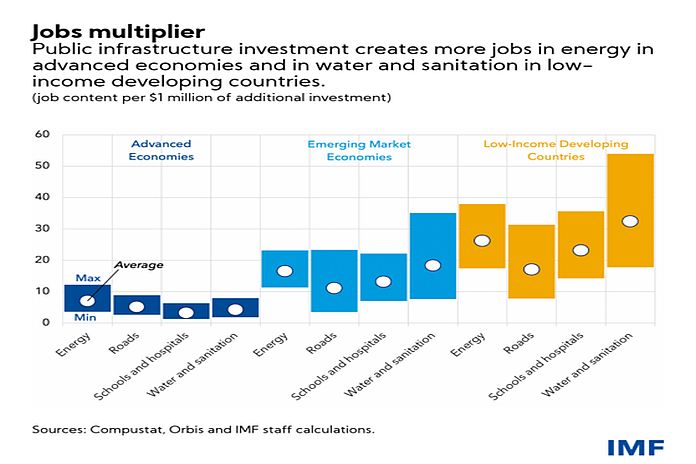For countries on the path to recovery, reviving economic activity is a major priority. And what better way to support a come-back than by creating jobs. Our new IMF staff research shows that when governments spend on infrastructure, they create many new jobs.
Drawing on a 19-year dataset of over 5,600 construction companies from 27 advanced economies and 14 emerging market economies, we use an innovative approach to measure the direct employment effect of $1 million of infrastructure spending by country income group and sector—electricity, roads, schools, hospitals, and water and sanitation. Because there is no data available for low-income developing countries, we estimate the employment impact by extrapolating from advanced economies and emerging market economies.
Our latest chart of the week shows average estimates, by sector, of the number of jobs that additional investments create along the supply chain. The amount of job creation depends on labor mobility how easy it is to move across companies within sectors and labor intensity defined as the labor effects down the supply chain in a sector. For example, in an emerging market economy with high labor mobility and high labor intensity, around 35 jobs are created in water and sanitation per $1 million of additional investment. In a country with low labor mobility and low labor intensity, that number falls to around eight.
In advanced economies, $1 million of spending can generate an average of three jobs in schools and hospitals and over six jobs in the energy sector, assuming intermediate labor mobility and labor intensity levels. In low-income developing countries, the estimates are much larger and range from 16 jobs in roads to 30 jobs in water and sanitation. Put differently, each unit of public infrastructure investment creates more direct jobs in electricity in high-income countries and more jobs in water and sanitation in low-income countries.
The benefits of investing in renewables and innovation
The impact could be higher for green investment, in part because many jobs in renewables do not require much education beyond high school and have low barriers to entry. Per $1 million invested, around 5–10 jobs could be created in green electricity, 2–12 jobs in efficient new buildings like schools and hospitals, and 5–14 in green water and sanitation through efficient agricultural pumps and recycling.
Investment in research and development can also create jobsthough mostly, if not exclusively for high-skilled workers. Despite it being a much smaller component of public investment, mostly to government institutions and higher education around 4 jobs are created in R&D per $1 million invested.
These results indicate that public spending on infrastructure can make a meaningful contribution to job creation. Overall, one percent of global GDP in public investment spending can create more than seven million jobs worldwide through direct employment effects alone.
![]()






